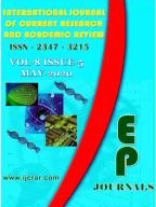Abstract Volume:8 Issue-5 Year-2020 Original Research Articles
 |
Online ISSN : 2347 - 3215 Issues : 12 per year Publisher : Excellent Publishers Email : editorijcret@gmail.com |
2Applied Ecological Labortory and Environmental of National University of Agronomie and Forester
Evaluation’s study of termitaries as the case of ecological habitat and its importance in the feeding of Chimpazees. (Pan.t. troglodytes) accomplished in the national park Nouabalé Ndoki in the northern part of Congo Brazzaville in Bomassa forest and triangle of Goualougo. The labor area was divided according to the type of vegetation found. In order to reach our gool, we lengthened those forests about 18,3km. In all studied forests, we observe 258 termitaries our studies show that the Chimpanzee had preferred staying in termetary zones depending on the type of forest. In order to feed itself in the white ant, the Chimpanzee caught the white ants using wood tools that it made in the forest two tools were picked up in the forest: defense and capture tools. In general, we enumerated 79 tools among which 23 were found the termitaries, 51 picked up in the field and 5 tools found on the way, so there are 56 capture tools and 23 defense tools.We think that the lack of defense tools around termitaries would be like the Chimpanzee made the tool and went with it towards another termitary to be used in the future. The analysis of the waterfree estate of those tools in wood made by the Chimpanzee atlwed us to classify them according to the time of use. The presence of Chimpanzee around termitaries according to the type of forest and time of use of tools could be served as a very gig opportunity for the developpement of ecotourism in the forest of national park of Nouabalé Ndoki.
How to cite this article:
MBETE Pierre, DZOHI- EPENIJacques and KOUBOUANAFélix. 2020. Termitièries: Ecological Habitat and Importance in the Food of the Chimpanzees (Side T troglodytes) in the Forest of Bomassa, the Forest of the Triangle of Goualougo within the National park Nouabalé Ndoki.Int.J.Curr.Res.Aca.Rev. 8(5): 1-8doi: https://doi.org/10.20546/ijcrar.2020.805.001



Quick Navigation
- Print Article
- Full Text PDF
- How to Cite this Article
- on Google
- on Google Scholor
- Citation Alert By Google Scholar
